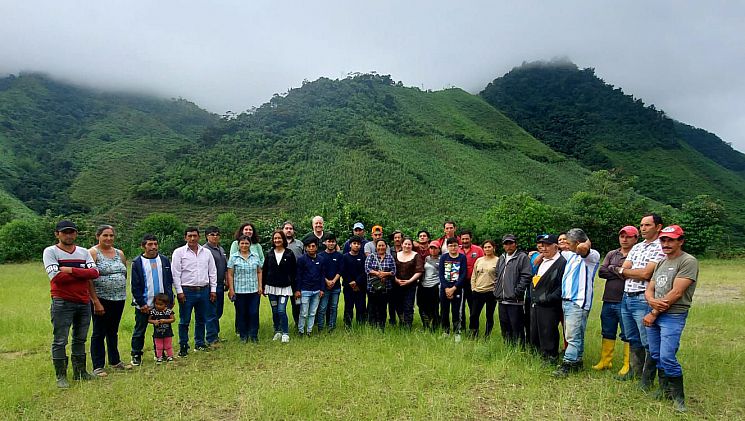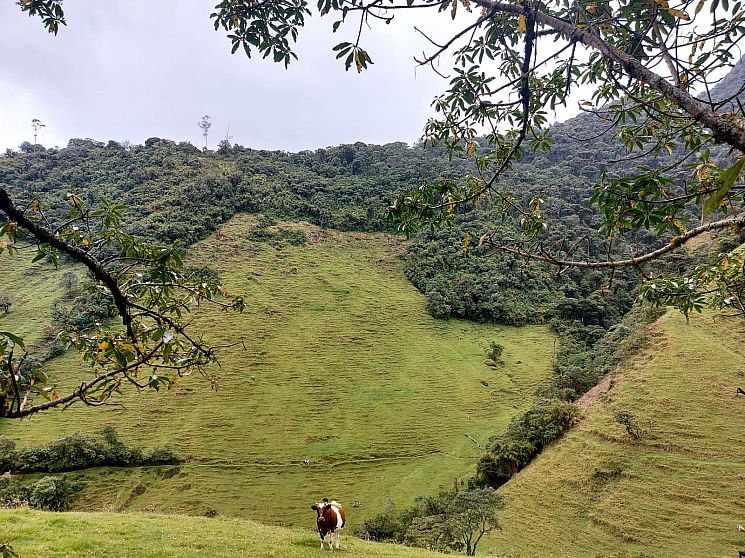Dr Joanna Smallwood: showcasing interdisciplinary research in the Ecuadorean Andes
Our Collaboration award-winner on co-learning with her team, the importance of SSRP coffee mornings and protecting the rights of the Andean Spectacled Bear (the real-life Paddington bear).
The progressive renegades who founded Sussex back in 1961 were early pioneers of interdisciplinary working. In a move that was radical for the time, they structured the university around 'schools' of study, aiming to build bridges between traditionally solo subjects. Working across disciplines has since become more of a norm in the sector, of course, but Sussex continues to value the collaborative spirit and aims to build on that legacy.
In theory it sounds idyllic, but working across disciplines is not always the easiest path. Reconciling complex methodologies, terminologies and priorities can present challenges, potentially leading to disagreements or slow progress. But if there’s anything to incite collaboration; it’s a complex real-world problem. And that’s exactly what The Andean Bear Research Action Group, which Dr Joanna Smallwood is part of, are rallying to resolve with their project in the Ecuadorian Andes.
Supporting communities and conservation
Sadly, like many rainforests, the highly biodiverse cloud forests of the Ecuadorian Andes are experiencing rapid deforestation, but here there is a unique set of complications. Jo explains “The deforestation seen in the Ecuadorean Andes is an interesting dynamic because the forest here is not being threatened by a big mining corporation or large-scale agricultural expansion like many other forests, these circumstances are much more delicate. Unlike other regions where industrial-scale operations drive deforestation, here it is small-scale farmers who rely on subsistence agriculture and cash crops like sugarcane to make a very modest living. One aspect of this project is that we are supporting the local communities by helping them gain access to land titles which have been promised by the government. A process which is extremely complex and time consuming.”

Bellavisata community workshop
Alongside empowering local communities, there are pressing conservation needs for the Andean Bear Research Action Group to address. The highly biodiverse Andes region is home to many endangered species, including the Andean Spectacled Bear (the very same species who allegedly inspired Michael Bond’s Paddington Bear). This area falls within the Andean Bear Corridor, which stretches across Ecuador and Peru, created to help conserve this species which is listed on the IUCN Red List as at risk of extinction.
“One of the threats to their existence and flourishing is loss of habitat,” Jo continues; “Another threat is human-wildlife conflict. As the areas of cloud forest have been reduced and fragmented, the bears are more likely to come onto the farmers’ land and eat their crops and allegedly predate their cattle. One possible solution is finding alternative livelihoods that reduce human-wildlife conflict and are attractive to local communities. When farmers apply for land titles within the protected forest, a condition is that they undertake sustainable farming and protect or restore 60% of the forest on their land. If farmers secure land tenure and agree to use alternative farming methods, potentially this is a way to reduce conflict. Our aim is to support the bears and other species living in the Ecuadorean Andes and facilitate forest preservation and restoration while supporting the local communities in securing land tenure and creating sustainable livelihoods.”
The rights of nature and sentient animals
Making the situation more interesting still, Ecuador was the first country to recognise the rights of nature and enshrine them in law within their constitution. This unique legal framework acknowledges the intrinsic value of nature, including wild animal species. This groundbreaking perspective forms the basis of Jo’s contribution to the project as a lawyer. Jo explains, “Here we see the intersection of different rights; the rights of nature, the social and economic rights of the local communities, but also, the rights of the bears, even one individual bear. This aspect of the rights of nature, relating to human-wildlife conflict, has not been tested in court, so that’s what really interests me.
A 2022 case concerned the rights of a domesticated woolly monkey, but this was in the exotic pet context. The rights of groups of wild species have been recognised, for example the rights of the long-nosed harlequin frog, but what I’m really interested in is the sentient animal aspect. So, my part of the project is looking at this intersection of different rights bearers and potentially testing them through the courts with strategic litigation. The idea is to identify and protect one individual bear (and as a consequence its natural habitat) using the rights of nature. I suppose this is the most radical part of the project, because it brings interspecies rights into the debate, it looks beyond nature as a broad concept to recognise the sentience of wild animals and seeks to find solutions to how a bear’s rights can be reconciled with the rights of local communities.”
The power of working across disciplines
The Andean Bear Research Action Group hope to identify one bear whose movements can be tracked to build a case for its protection. And here is where the need for interdisciplinary expertise becomes clear. This effort involves ecologists, anthropologists, geographers and lawyers, each bringing their expertise to tackle the complex interplay between legal, environmental and social issues. Jo highlights the importance of this approach. “That’s why the interdisciplinary element is so important because we need to look at the situation from lots of different angles. Professor Fiona Mathews and other ecologists on the team will be looking at many issues surrounding the forest and sustainable livelihoods, including studying the bears’ behaviour and using camera trap data to look at the movements of bears and better understand how they conflict with human land use. I have been consulting with our local partners and lawyers in Ecuador who are supporting local communities to secure land titles and to investigate the potential of strategic litigation and how this would proceed. Dr Evan Killick, our anthropologist, is focused on better understanding the communities' needs and perspectives and how they feel about nature and the bears and alternative livelihoods. Professor Alexander Antonarakis, our geographer, is looking at the value of different products in the forest for the communities and other potential mechanisms through which local communities can benefit, such as carbon credits.”
Having experienced it first hand, Jo agrees that the benefits of interdisciplinary working outweigh the challenges, noting that the collaboration aspect has enhanced the scope of the research beyond what any of them individually could have imagined, “It is more complicated doing interdisciplinary research, but the results are going to be much more relevant to society and the environment than if just one of us took this ahead on our own. We now have several different avenues for impact.”
Building the dream team
So how does one go about pulling together a super group of researchers? Jo explains just how helpful the SSRP (Sussex Sustainability Research Project) has been for bringing them all together, one of twelve interdisciplinary ‘Centres of Excellence’ since these launched at Sussex in 2023. “The SSRP have been crucial in making us all known to each other. I know everyone is busy, but just taking a moment to go to these coffee mornings for networking and chatting is important as it gives opportunities early on in research projects to reach out to people. Initially, Professor Fiona Mathews was undertaking work in the Ecuadorian Andes relating to vanilla propagation for sustainable livelihoods, she then approached me and asked if I wanted to come on board because of the legal aspect. Fiona initiated the project and already had a well-established network of local partners. Dr Evan Killick is fluent in Spanish and an amazing anthropologist, and he came on board to look deeply at the local communities' perspectives. Dr Alexander Antonarakis joined the team interested in mapping the forests and forest products. It all happened very naturally.”

Deforested land
Learning together for lasting solutions
The Andean Bear Research Action Group’s project clearly demonstrates the strength of interdisciplinary collaboration. By fostering mutual learning, the team has been able to work towards finding solutions that benefit both Andean bears and the local communities. As Jo concludes: “Our working hasn’t been siloed, we work closely together and learn from each other, which has been a lovely aspect of this project. We are all just really motivated to find an equitable solution for both bears and local communities, one which hopefully can be scaled up throughout the whole Andean bear corridor. Not one of us alone could really do justice to this project, but all of us together are a force to be reckoned with because we are testing and enhancing each other’s understanding.”
The plight of the Andean bear has recently gained attention through popular culture, with the Paddington franchise of books and films sparking interest in the species. However, real-life Andean bears face serious threats that require complex conservation efforts. And Jo explains their preference would actually be wild avocadoes over marmalade sandwiches…
If you would like to donate to help the Andean Bear Research Action Group protect the rights of the real-life Paddington bears (Andean Bears), the forests and local communities in the Ecuadorian Andes, please visit their Justgiving page: Andean Bear Research and Action - JustGiving